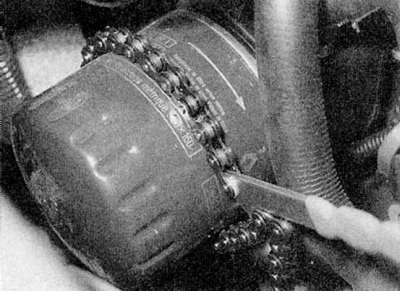
1. Before starting this procedure, prepare all the necessary tools and materials, as well as rags and old newspapers, to wipe up spilled drops. It is better to keep the engine oil warm, this will allow it to drain faster and remove more sediment with the oil. When working under a vehicle, do not touch hot parts of the engine. Wear gloves to protect yourself from possible oil contact with your skin (refer to accompanying illustration).
2. Engage the handbrake, then jack up the front of the vehicle and place it on axle stands. Loosen the mounting screws and remove the plastic protective cover from the bottom of the engine.
3. Remove the oil filler cap.

4. Using a wrench, loosen the drain plug approximately one half turn. Place a drain container under the drain plug and unscrew it completely (refer to accompanying illustration). Remove the sealing washer.
5. Let the oil drain. Note that it may be necessary to move the container when the dripping oil turns into a thin stream.
6. After the oil is drained, wipe the drain plug and seal with a clean cloth. Inspect the gasket and replace if damaged or worn. Clean the area around the drain hole and install the plug along with the gasket. Tighten the plug securely.
7. Move the container under the oil filter, which is located on the front of the cylinder block.

8. Use a special tool (refer to illustrations), to loosen the filter, then unscrew it by hand. Drain the oil from the filter into a container.
9. Use a clean cloth to remove any oil and dirt that has settled around the filter mount on the engine. If the filter rubber o-ring remains on the engine, carefully remove it.

10. Take a new filter, lubricate its O-ring with clean oil and install the filter on the engine. Tighten the filter by hand - do not use any tools (refer to accompanying illustration).
11. Install the protective cover and securely tighten the fixing screws. Remove the drained oil and all tools from under the vehicle, then lower the vehicle to the ground.
12. Fill the engine with the correct grade and type of oil through the filler hole in the camshaft cover. First, pour in half the required amount of oil and wait a few minutes to allow the oil to drain into the pan. Add oil in small portions until the level reaches the lower mark on the dipstick, then add approximately 1 liter more to bring the level up to the upper mark on the dipstick.
13. Start the engine, let it run for a few minutes and check for leaks around the oil filter seal and sump drain plug. Note that the low oil pressure warning light may go out with a delay of a few seconds to allow oil to fill all relevant passages and a new oil filter.
14. On diesel models with a turbocharger, before starting the engine, perform the following procedures:
- a) Disconnect the wiring from the fuel cutoff valve on the fuel pump and isolate the connector.
- b) Check the engine with the starter until the oil pressure warning light goes out (it may take a few seconds).
- With) Connect the wiring harness to the fuel cutoff valve, then start the engine.
- d) With the engine idling, check the turbocharger oil and coolant couplers for leaks.
15. Stop the engine and wait a few minutes for the oil to drain into the sump. Recheck the level and add oil as needed.
